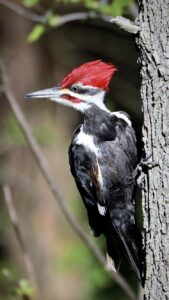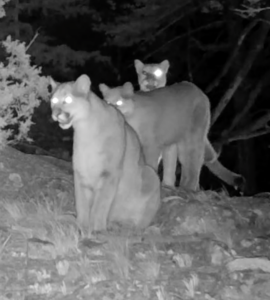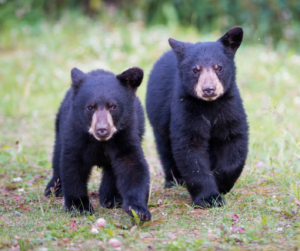News & Commentary
Why Florida’s Right to Hunt Amendment is Unnecessary

Wildlife for All joined the list of groups opposed to a proposed Florida constitutional amendment on the ballot in November (2024) that would enshrine hunting and fishing as the preferred method of wildlife management in that state, including “traditional” methods like leghold traps, neck snares, and hunting with hounds. Approximately half of U.S. states currently have Right to Hunt amendments. On the surface, these laws appear uncontroversial to many, as most people generally support the right to hunt and fish for food. However, the push to include these amendments in more states is largely reactionary and aimed around endorsing an outdated status quo of wildlife management prioritizing hunters and hunting. Right to Hunt measures are unnecessary and often deceptively framed.
Groups pushing these amendments include the NRA and organizations promoting the status quo in wildlife management like the Congressional Sportsmen Foundation and the International Order of T. Roosevelt. The Florida Right to Hunt adds language favoring hunting “as preferred means of responsibly managing and controlling fish and wildlife” giving preferential treatment to hunters and hunting. Not all methods of hunting sanctioned by state wildlife agencies are favored by the public. Broad wording like “including by the use of traditional methods” endorses practices that garner strong public disapproval but are currently legal in many states, like using hounds and bait to hunt black bears.
The language and motives behind these amendments underscore the importance of understanding the current system in wildlife management and the need for a more democratic, just, and ecological system. WFA opposes these measures because they make it more difficult to pass needed reforms like banning wildlife killing contests, they privilege consumptive users over the public in wildlife matters, and they are unnecessary because there is no serious effort to ban hunting in any state.
New Mexico’s Green Amendment

Climate change impacts both people and wildlife, especially in arid regions, which are at heightened risk of wildfires and drought. Environmental hazards, pollution, degradation, and biodiversity loss also disproportionately affect low-income and minority communities. A proposed New Mexico Green Amendment promotes environmental equity and the right of all people to a safe and healthy environment. Pennsylvania, New York, and Montana currently have similar measures in their state constitutions. In addition, the New Mexico amendment would ensure stronger protections for the state’s wildlife, promoting healthy ecosystems and native species as a public trust.
A bill to place the Green Amendment on the ballot for November 2025 will be introduced in the next New Mexico legislative session in January 2025.
Wildlife For All supports this effort because:
- The measure would guarantee New Mexicans the right to a healthy environment, including native flora, fauna and ecosystems. Individuals could go to court to force the government to take action if this right was violated.
- It would explicitly acknowledge that wildlife and natural resources are part of the public trust that the government, as trustee, has a duty to protect for the benefit of all people, including future generations.
The current proposed language for the New Mexico Green Amendment is:
It is proposed to amend Article 2 of the constitution of New Mexico by adding: A. The people of the state shall be entitled to clean and healthy air, water, soil and environments; healthy native flora, fauna and ecosystems, and a safe climate; for the benefit of public health, safety and general welfare. The state shall protect these rights equitably for all people regardless of race, ethnicity, tribal affiliation, gender, socioeconomics, or geography. B. The state, counties and municipalities shall serve as trustee of the natural resources of New Mexico and shall conserve, protect and maintain these resources for the benefit of all the people, including present and future generations. C. The provisions of this section are self-executing. Monetary damages shall not be awarded for a violation of this section. This section is enforceable against the state, counties and municipalities.
The Role of Wildlife Governance in Rewilding

Mountain lions, while considered a species of “Least Concern” overall, remain absent from much of their original range, including the eastern United States.
State wildlife agencies are failing to restore and protect wildlife because they prioritize the wrong objectives, according to a new study in the journal Bioscience. Many keystone species could feasibly return to portions of their historic ranges where they no longer occur, but state wildlife agencies ignore and do not restore them. Overall, agencies are more focused on providing opportunities for hunting, fishing and trapping than on wildlife recovery.
The idea of rewilding – restoring wildlife to strengthen habitat resilience and biodiversity – is gaining traction. Historic and current conservation efforts have primarily focused on species-level extinctions. Geographic range contraction, while frequently overlooked, is a critical aspect of the biodiversity crisis. Mountain lions for example, while not federally threatened or endangered, remain extirpated (locally extinct) across significant areas of their former range. Where present, mountain lions are a keystone species. Since administration of the federal Endangered Species Act currently does nothing to address range contraction, this issue often falls to state wildlife agencies. This presents an obstacle for restoration of native carnivores and other species that hunters do not prioritize but are ecologically important.
An article published in Bioscience demonstrates strong support for rewilding species that are extirpated or locally endangered. The researchers found that the public generally thinks wildlife managers should prioritize wildlife restoration over providing hunting and fishing opportunities. This approach means acknowledging the ecological importance of wildlife (not just utilitarian benefits to humans) and the critical role a species is unable to fulfill in regions where they have become locally extinct due to historical persecution, unregulated hunting, or habitat degradation. Rewilding wildlife like wolves, beavers, bison, and mountain lions would also restore lost ecosystem functions in those places. Americans increasingly favor a more inclusive, ecologically-driven approach to state wildlife management that looks to the future and engages with hunters and non-hunters alike.
Wyoming Wolf Torture Incident Highlights Need to Drastically Reform State Wildlife Management

Cody Roberts poses with wolf he injured with his snowmobile. Photo courtesy of the Cowboy State Daily.
In a press release issued today, Wildlife for All joined a coalition of other wildlife, hunting, animal welfare, scientific, and governance reform organizations in calling for Wyoming and other states to overhaul their wildlife management policies in the wake of an incident of a wolf having been captured and tortured in Wyoming.
The case has gained national attention. As reported by KHOL 89.1 radio on March 29, 2024 a Wyoming man injured a gray wolf with his snowmobile, taped the wolf’s mouth shut, brought the animal to a home and then a local bar where the wolf was eventually killed after several hours of being paraded around the bar. The Wyoming Game and Fish Department states that the only crime the man violated is possession of a living, warm blooded wild animal, which is a violation of Wyoming law that carries a maximum $250 fine. He was fined $250, and, to our knowledge, the state wildlife management agency has not indicated that any further investigation is being conducted.
The incident reveals fundamental problems with the way Wyoming and many other states manage wildlife. The lack of protection for wolves and other carnivores encourages this type of cruel behavior. We are calling on Wyoming and other states to make fundamental changes to wildlife policy to prevent such incidents from happening again.
A Proposed VT Bill Would Add Nonhunters to the Fish and Wildlife Board

Currently only hunters, anglers and trappers can serve on the board that sets wildlife policy in Vermont. A bill in the legislature would change that by requiring “more balanced viewpoints” on the board (read a NYT feature on the bill here). Hunters object, saying the current system works fine so why change it? But if that is true, why does Vermont identify more than 1000 species in need of conservation attention in its state wildlilfe action plan?
Do cougars require killing?

It is often said that cougars and other carnivores need to be hunted to keep their numbers in check. Otherwise, they would deplete deer populations, and attack too many livestock and even people. That is the what opponents say of a Colorado ballot initiative that would end hunting and trapping of cougars, bobcats and lynx. However, these claims are not supported by science, as hunter and outdoor writer Ted Williams explains in this essay.
For Asha, Let Nature Takes Its Course

Captive Mexican Wolf at Sevilleta National Wildlife Refuge, New Mexico. (Source: USFW)
In the vast expanse of Southwestern wild places, one lone wolf has captivated the hearts of many — Asha, the dispersing Mexican gray wolf on a journey of epic proportions.
As she roams across the landscapes of Northern New Mexico for the second time, her path not only tells the story of a remarkable individual but also unveils the secrets of critical dispersal corridors that are essential for the survival of her species. Recent observations of Asha’s movements raise questions about the wisdom of intervening in her natural wanderings. As the New Mexico Department of Game and Fish and U.S. Fish and Wildlife Service contemplate the potential need for human intervention — they’re letting Asha alone for now — it is crucial to consider the broader implications of her journey, not just for her but for the entire ecosystem.
One study on wolf dispersal highlights a corridor spanning around 26 miles, connecting core Mexican gray wolf habitat in the Gila National Forest to suitable habitat in the Jemez Mountains and beyond in southwestern Colorado. This corridor, just over half a mile wide in some areas, stands as a critical pathway for the dispersal of wolves in the region.
The precarious nature of this corridor, or other possible paths delicately following the remnants of forested land cover, underscores the challenges faced by Mexican wolves like Asha. The conversion of vital habitats into cropland exacerbates the already arduous task of crossing the diverse terrains of the Southwest. Not having access to the details of Asha’s GPS collar data, we can only surmise that she may have followed this corridor.
Wherever her exact path has taken, we can be confident that it’s been a dangerous one at times. Crossing Interstate 40, the arbitrary boundary the U.S. Fish and Wildlife Service has set for lobos, is just one of many challenges she faces. In addition to vehicles moving at lethal speeds, bullets intended for coyotes might find their way to Asha. It wouldn’t be the first time.
Asha’s journey serves as a living testament to the importance of preserving these tenuous corridors and allowing wild wolves (and other animals) to use these corridors in pursuit of suitable core wildlands.
By allowing her to roam freely, the agencies have the opportunity to showcase the significance of such pathways for the recovery of wolf populations not only in Northern New Mexico but potentially in southern Colorado and Utah. Asha, in her quest for a mate, is becoming a pioneer for lobo recovery in these regions. Independent, peer-reviewed scientific studies assert that the recovery of Mexican gray wolves hinges on their access to habitats in the Southern Rocky Mountains and Grand Canyon Ecosystem, both situated north of I-40. Ideal habitats for Mexican wolves extend beyond this geographical boundary, emphasizing the importance of recognizing their inherent need to follow natural corridors and establish sub-populations in additional areas.
As we follow Asha’s trail, let’s celebrate her resilience and acknowledge that sometimes, the best course of action is to let nature take its course. Resisting the urge to intervene in wild animals’ lives is an essential aspect of coexistence, where humans and animals learn to live with each other.
Peacefully accommodating our neighbors of all ilk is the only way we and our hot, hungry, and crowed planet will survive the current crises we face. Contact Gov. Michelle Lujan Grisham and ask her to rescind New Mexico’s opposition to wolf recovery efforts north of I-40. In doing so, we may find that Asha’s path becomes a beacon for larger rewilding initiatives, emphasizing the critical role of dispersal corridors in the preservation of wildlife and wild places.
This first appeared as an op-ed in the Santa Fe New Mexican. For more on this topic, read about Asha’s first journey and its ending by capture here.
Proposed Washington State Policy Seeks to Define, Prioritize “Conservation”

Given how important “conservation” is to, well, protecting wildlife, you’d think that there would be general agreement on what the term means. Turns out that is not the case. Although the word appears in many state statutes, it often goes undefined, leading to widespread confusion about what state wildlife managers ought to be doing.
In an effort to provide guidance to Washington State wildlife managers in the face of a biodiversity crisis and other threats, in 2021 the Washington Fish and Wildlife Commission (WFWC) released a three-page draft conservation policy.
The proposed policy declares conservation of the state’s wildlife for the benefit of all residents to be the top priority of wildlife management in the state. Conservation is defined as: Science informed actions to preserve the health and resilience of natural environments including fish, wildlife and humans, safeguard the intrinsic value of nature, and provide equitable benefits to current and future generations of human and non-human life. These actions include protecting and restoring air, soil, water, biological diversity, ecosystem processes and evolutionary potential.
The draft policy has proved surprisingly controversial. Wildlife advocates like Washington Wildlife First–a Wildlife for All coalition partner–strongly support it, but many hunting groups like the Rocky Mountain Elk Foundation oppose it as a threat to traditional values and hunting culture. They object to the use of terms like “preserve” and “intrinsic value” in the definition of conservation, which they argue should emphasize sustainable consumptive use of wildlife.
The debate in Washington over something as fundamental as the meaning and importance of conservation indicates how entrenched state wildlife management is throughout the U.S., and the challenge Wildlife for All and our partners face in reforming it.
WFWC hopes to finalize the policy before the end of the year. Read more at this Columbia Insight article here.
Lawsuit Challenges NJ Law Giving Hunters Majority on State Fish and Wildlife Council

A former New Jersey state legislator filed a lawsuit challenging the constitutionality of a state law that effectively gives hunting groups the power to select a majority of the 11-member NJ Fish and Wildlife Council, which sets wildlife policy for the state. The lawsuit was filed by former senator Ray Lesniak and the Lesniak Institute. Lesniak argued that the law which requires the governor to appoint six members to the Council from a list of recommended candidates submitted by the New Jersey State Federation of Sportmen’s Clubs effectively gives outsized power to a private interest group, in violation of the state constitution’s establishment of three distinct branches of government: legislative, executive and judicial. The judge denied Lesniak’s request for a preliminary injunction to halt the fall bear hunt, which began October 9. Lesniak said he will appeal.
In an op-ed published in NJ.com, Wildlife for All co-executive directors Michelle Lute and Kevin Bixby applauded the lawsuit. “If successful, this litigation would end the stranglehold that a shrinking but powerful interest group–hunters–have long had on wildlife matters in New Jersey. It would set an important precedent that would open the door to democratizing wildlife management in other states, bringing fairness and justice to one of the least democratic arenas of public policy in the U.S.”
Stop next week’s bear hunt wildlife conservationists plead

The December black bear hunt begins on Monday. Harvested bears are brought to the Whittingham Wildlife Management Area check station in Freon where they are tagged by the New Jersey Division of Fish and Wildlife. December 5, 2016 (Patti Sapone | NJ Advance Media for NJ.com) Patti Sapone | NJ Advance MediaPatti Sapone | NJ Advance Media
By Kevin Bixby and Michelle Lute
In the world of wildlife management, few issues have sparked as much debate as the treatment of New Jersey’s bear population. A lawsuit brought by former state Senator Raymond Lesniak challenges the recent decision by the New Jersey Fish & Game Council to allow bear hunting for the next five years and seeks a preliminary injunction to halt this year’s bear season, scheduled to begin Oct. 9.
Lesniak’s lawsuit, filed on behalf of The Lesniak Institute and himself, is about more than bears. It raises questions about the outsize influence of private interests on the state’s Fish & Game Council’s decision making and shines a light on the undemocratic nature of wildlife governance in New Jersey.
We at Wildlife for All applaud the lawsuit. Our mission is to reform state wildlife management in every state to be more democratic, just, compassionate and focused on protecting all wild species in the face of climate change and a global extinction crisis.
If successful, this litigation would end the stranglehold that a shrinking but powerful interest group — hunters — have long had on wildlife matters in New Jersey. It would set an important precedent that would open the door to democratizing wildlife management in other states, bringing fairness and justice to one of the least democratic arenas of public policy in the U.S.
Lesniak’s lawsuit revolves around a seemingly simple yet profoundly significant argument: the composition of the Fish & Game Council violates Article III of the New Jersey Constitution, which establishes a three-branch system of government with distinct legislative, executive, and judicial functions.
Lesniak contends that undue influence is wielded by the Federation of Sportsmen’s Clubs, a private organization, within the Council. With six of 11 council members appointed based on recommendations from these clubs, the lawsuit asserts that essential government functions are effectively outsourced to a select interest group.
At the heart of the issue lies the upcoming bear hunt to be held this month. Although the Fish & Game Council justified the hunt as needed to reduce human-bear conflicts, it has failed to pursue non-lethal methods of preventing conflict, such as requiring bear-resistant trash cans and discouraging bird feeders in bear country. These evidence-based measures are proven to significantly reduce incentives for bears to venture into residential areas for food.
The core of the issue is the unchecked authority of the Sportsmen’s Clubs in shaping New Jersey’s wildlife management policies, which results in the Council’s apparent bias in favor of hunting as the primary means of wildlife management. This predisposition permeates every aspect of the Council’s policies and actions, marginalizing non-lethal solutions that could be more effective, humane, and sustainable in the long run.
Lesniak’s lawsuit seeks to prevent further harm to New Jersey’s bears. This measure underscores the urgency of the situation and the need for immediate judicial intervention to protect the state’s wildlife — a goal fully in line with Wildlife for All’s mission to ensure the well-being of all species.
This legal battle serves as a poignant reminder of the critical role that individuals and organizations play in safeguarding our natural world. Lesniak’s challenge against the Fish & Game Council’s composition not only raises concerns about the undue influence of interest groups but also advocates for a more transparent, data-driven, and ecologically responsible approach to wildlife management.
It is crucial to acknowledge that Lesniak is not alone in his concerns. A growing chorus of voices within the environmental community and the broader public have expressed skepticism about the bear hunt and the overarching policies of the Fish & Game Council.
As the lawsuit unfolds, it will undoubtedly attract the attention of those who believe that the fate of New Jersey’s wildlife should not be determined solely by a select few but should be a matter of public interest and informed, democratic decision-making, consistent with the commitment to equitable representation from Wildlife for All and our growing coalition of over 60 organizations.
This lawsuit against the New Jersey Fish & Game Council serves as a pivotal moment in the ongoing debate over wildlife conservation in the state. It challenges the status quo, raises essential questions about constitutional principles, and advocates for a more balanced and sustainable approach to protecting New Jersey’s bears and wildlife in general. With its success, New Jersey can become a model of democratic, effective wildlife policy-making.
Regardless of the lawsuit’s outcome, it underscores the importance of vigilant oversight and citizen engagement in matters that impact the environment we all share.
Kevin Bixby is the founder and co-executive director of Wildlife for All.
Michelle Lute has a Ph.D in wildlife conservation and serves as co-executive director of Wildlife for All. Kevin and Michelle have a collective six decades of wildlife conservation experience.
This first appeared as an op-ed in the New Jersey Star-Ledger
